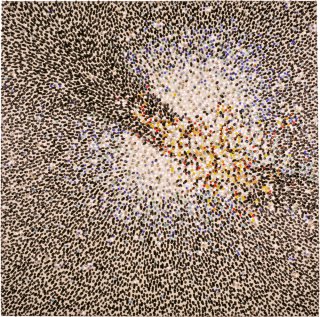
John Francis Torreano
Exploding Galaxy
(born 1941)
American 1981 Acrylic paint, glue, and plastic and glass jewels on canvas 84 x 84 inches Museum purchase with funds provided by the 1987 and 1988 Associate Board Art Ball 1987.147 223
The Many Facets of a Gem
John Torreano’s Exploding Galaxy is comprised of dabs of acrylic paint and shimmering glass gems applied to bare canvas. Viewers exploring its shifting, kaleidoscopic surface have arrived at various interpretations, drawing comparisons with space, religion, morality, and much more. What do you think its many facets reveal?
A Day in the Life
Tools and Techniques
Behind the Scenes
Look Closer
Pick a Perspective
Take a moment to practice your formal analysis skills. Look at how changing one’s perspective transforms Exploding Galaxy’s overall impression. From afar, the painting might read like a night sky, the lighter colors and wider spacing of dots in its center suggest an expanding galaxy. Yet, as one approaches, the image soon becomes overwhelming in size, and dissolves into an abstract conglomeration of distinct gems and dabs of paint, applied in a thick impasto on the canvas’s surface.
Shifting in front of the object also offers varied sights: the glass gems embedded within the strokes of black, blue, and white wink and glitter as one passes by, animated by and reflecting light. Standing in a crowd, no two viewers exactly see the same painting.
Poll
Which viewpoint do you find most pleasing?
Just for Kids
Look!
As you look at the night sky, it can be hard to see the stars clearly without using a telescope. When first looking at Exploding Galaxy, try standing far away from it. What do you notice? Slowly move closer. Focus on your favorite part. What do you notice as you move in? Does it change as you get closer?
Signs & Symbols
Dig Deeper
A Galaxy of Meaning
Many critics have referenced the religious undertones of Torreano’s work, given the artist’s Roman Catholic upbringing and his own comparisons between shimmering fake gems and "vigil lights." The connections become even more appropriate considering the artist also makes gem-encrusted crosses, which he has often exhibited alongside his other works, including this painting.
While Exploding Galaxy might hold religious connotations for some, other viewers may not discern this facet of the piece at all. The artist himself has argued that different experiences in life lead to different modes of perception and interpretation, which attests to the fact that an artist’s intentions may not hold fast once a work is put out into the world for viewers to observe and appreciate. For example, others have considered his work, with its plastic and glass fake jewels, a metaphor for the material abundance yet spiritual impoverishment of the world. Take a moment to think about how these notions affect how you interpret Exploding Galaxy.

John Francis Torreano, Yellow Cross, 1993, mixed media, 30 x 30 inches. Private collection (artwork © John Torreano; photograph provided by John Torreano).
Arts Intersected
The Sculpture Speaks
Did You Know?
It Came from Outer Space
Mr. Torreano worked from a photo of the “Centaurus A” starburst galaxy to make this piece, and many of his later space-themed creations are based on photos from the Hubble Space Telescope. Watch the video below to see how Exploding Galaxy compares to recent images of “Centaurus A” taken by a high-powered telescope.
Zooming in on the Strange Galaxy Centaurus A, 2012. ESO/Nick Risinger (skysurvey.org). Music: Disasterpeace (http://disasterpeace.com/).
Expert Opinion
Look Around
About the Artist
Jack of all Trades, Master Jeweler

Still from John Torreano Art World Wizard, 1986 (image copyright of the artist; courtesy of Video Data Bank, www.vdb.org).
Born in 1941 in Flint, Michigan, John Torreano received his MFA from Ohio State University in 1967. His work, like that of many artists of his generation, investigates the three-dimensionality of paintings—the way in which depth and space may appear in a flat canvas. Initially he used simple dots of paint in different sizes and shades to convey depth, but by the 1970s his canvases sported plastic and glass gems, a motif he has faithfully employed over time and across mediums. Mixed media objects by Torreano have been exhibited at notable institutions ranging from the Museum of Modern Art, New York, to the Carl Solway Gallery in Cincinnati.
Quiz
Besides art, guess what other field has Mr. Torreano dipped his toe in?
A. Comedy
B. Writing
C. Acting
D. Martial Arts
E. Teaching
Answer: Trick question! All of the above. Mr. Torreano was once a stand-up comedian, played a parody version of himself in the MICA TV 1986 short film John Torreano Art World Wizard (still image shown above), has a black belt in Judo, and published a book called Drawing by Seeing in 2007. Today he teaches studio art at New York University.
Talk Back
For Art’s Sake
Torreano’s work might be considered art for art’s sake, out of touch with the interests of larger society, engaging in highly intellectual questions about medium, the nature of art, and its relationship with the viewer. Without knowing any of the theoretical concerns explained in the tabs above, how do you still appreciate the aesthetic qualities of Exploding Galaxy?
